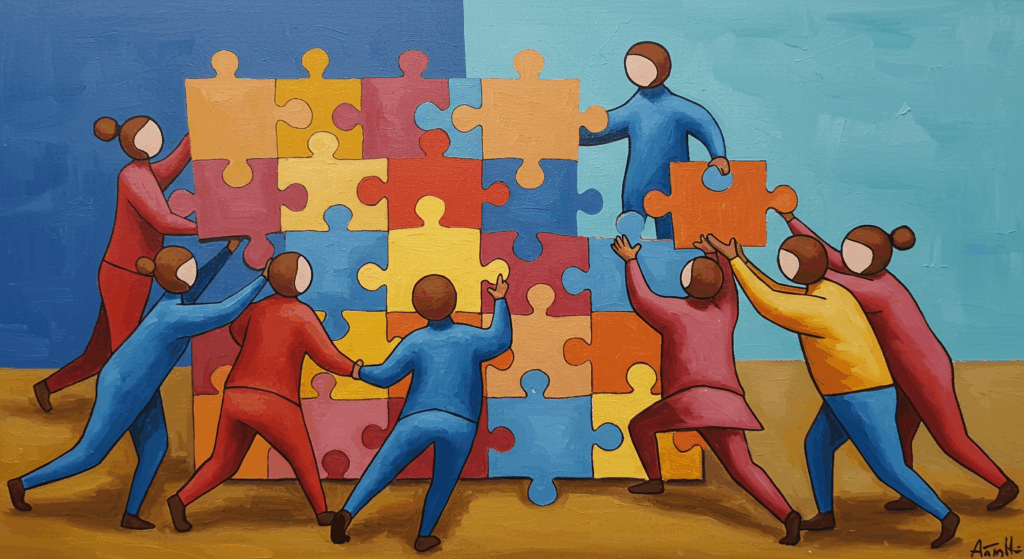Look, I love a good trust fall as much as… literally no one. If you’ve ever been forced to fall backwards into the arms of a co-worker you just met on Slack, you know the vibe: awkward, sweaty palms, and a silent prayer that HR doesn’t need to file a “whoopsie” report. But here’s the deal—team building can be fun, useful, and not a total cringe-fest. With the right mix of structure and spontaneity, you can create small moments that roll up into big outcomes: better communication, higher employee engagement, and legit workplace synergy (yes, I said it, and yes, I mean it).
In this guide, I’m going to share team building ideas for the workplace that feel human—stuff that works for Gen Z and Millennials who live on memes and caffeine, but also respect time, boundaries, and, you know, actual productivity. We’ll talk quick icebreakers that don’t suck, recurring rituals your people might weirdly look forward to, and corporate events that don’t feel like corporate events. Promise.
Why Team Building Still Matters (Even If Slack Has 47 Channels Already)
Alright, so we already spend all day “together” online—why do we need more bonding? Because relationships aren’t just about exposure; they’re about shared experiences that create shortcuts for trust and creativity. When teams feel safe, heard, and slightly hyped, they collaborate faster, challenge ideas without drama, and fix problems before they snowball. That’s where strong employee engagement comes from. And when engagement goes up, the whole system clicks—deadlines, deliverables, even the vibes. Hello, workplace synergy.
Also, people don’t quit jobs; they quit managers and cultures. Building a culture where folks actually enjoy logging in (or walking in) is a strategic flex, not just a nice-to-have. It’s retention, innovation, and low-key a brand advantage when candidates ask “what’s it like to work there?”
The Secret Sauce: Principles That Make Team Building Stick
Before we dive into ideas, a few rules of thumb (learned the hard way, ngl):
- Micro over mega. Tiny, frequent rituals beat one giant annual offsite. Consistency >>> intensity.
- Opt-in beats forced fun. People shouldn’t feel punished for having social batteries at 10%.
- Purpose > party. The best activities connect to how the team works: communication, feedback, problem-solving, focus, creativity.
- Inclusive by design. Every body, every brain. Avoid activities that require athleticism, alcohol, or after-hours childcare to “belong.”
- Make the outcome visible. Document wins. Capture learning. Track progress. It’s not school, but reflection helps.
- Short, sweet, scheduled. Block the calendar. Keep most activities under 30–60 mins. Start and end on time. Respect energy.
Okay. Now onto the good stuff.
Quick Wins: 15–30 Minute Boosters You Can Run This Week
These are bite-size activities that cost almost nothing and create fast momentum.
1) Rose–Thorn–Bud (5–10 min)
Each person shares:
- Rose: something good that happened
- Thorn: a challenge
- Bud: something they’re excited about
Why it works: Aligns mood + priorities without oversharing. Great weekly opener.
2) One-Question Round (7 min)
Pick a fresh prompt each week:
- What’s a micro-habit that’s improved your work lately?
- What song is your current productivity cheat code? (I see you, Spotify warriors.)
- What’s a tiny decision you made last week that paid off?
This is low-lift, low-awkward, and surprisingly bonding.
3) “Unblock Me” Blitz (15 min)
Everyone names one blocker. The group offers suggestions or intros. You leave with action items. It’s like Mario Kart but for bottlenecks.
4) Screenshot Show-and-Tell (10 min)
Share a screenshot that made you go “huh” (a dashboard, a customer email, a feature quirk). Two minutes each. Tiny, nerdy, useful.
5) Praise Parade (10 min)
Each person shouts out one teammate for something specific they did. Not “Sarah is great.” More like, “Sarah turned a vague client note into a clean spec in 15 minutes.” Recognition fuels employee engagement without costing a cent.
Recurring Rituals That Build Culture (Like, in a Good Way)
6) Demo Days, But Chill (30–45 min, monthly)
Team members demo something small: a prototype, a query, a process fix. Keep it scrappy. No 40-slide decks. Celebrate learning over polish.
7) Focus Power Hour (Weekly)
Everyone joins a call, cameras optional, mics off. Work silently for 50 min, then 10 min debrief: What moved? What’s next? It’s the digital coworking we secretly want.
8) Problem Jam (45 min, biweekly)
Pick one gnarly issue. Split into small groups. Brainstorm solutions for 20 minutes. Return with 1–2 proposals each. Vote. Assign owners. Ta-da—workplace synergy in action.
9) “Teach Me in 10” (10 min, weekly)
Lightning micro-lesson: keyboard shortcuts, how to structure a PRD, basic SQL, Canva hacks, “wording that gets quick approvals,” whatever. Rotates weekly. It compounds.
10) Friday Gratitude + Win Reel (15 min)
Quick round of gratitude + a running list of wins in Notion or a shared doc. Over time it becomes your team’s highlight reel. Super clutch for reviews and morale.
Corporate Events That Don’t Feel Like Corporate Events
A lot of corporate events have the vibe of a mandatory family reunion. Let’s fix that. The trick is to keep it purposeful, time-bound, and designed for low social pressure.
11) The Tiny Hackathon (Half-day)
- Theme: “Make life 10% easier.”
- Constraint: 3 hours, max 3 people per team.
- Deliverable: Demo something that saves someone time.
- Win condition: A judge panel (or the team) votes on Most Useful, Most Delightful, and Spiciest Shortcut.
Outcomes: Practical tools, shared learning, joyful chaos. It screams employee engagement.
12) Field Trip with a Work Twist (2–3 hours)
Example: Visit a local museum for a design-thinking scavenger hunt. Or a botanical garden to practice observation. Or a coffee roastery to map “customer journey” from bean to latte. Discuss parallels to your product/service. Bonus: good content for employer branding.
13) Service Day (Half-day)
Volunteer together—Food bank packing, beach cleanup, career talks at a local school. Keep the logistics tight and the expectcations humble. This builds meaning and trust, not just memories.
14) “Customer Listening” Live (60–90 min)
Invite 2–3 customers for a panel (offer a small stipend or swag). Ask what’s working, what’s missing, what they wish you’d stop doing. Then debrief as a team. Action over applause. It’s an event that fuels real improvements.
15) Mini Offsite, Maxi Intent (3 hours)
- 30 min: State of the Team (wins, lessons, numbers)
- 60 min: Strategy workshop (choose one thorny decision)
- 30 min: Break
- 45 min: Role clarity + dependencies
- 15 min: Commitments + dates
Follow with a casual snack/drink. That’s it. No “trust games,” no endless slides.
Remote & Hybrid: Team Building Without Forcing “Always On” Zoom
Remote culture is highly allergic to cringe, so we adapt.
16) Asynchronous “Team Album”
Create a shared folder where people drop one photo a week with a caption: a pet being weird, a desk plant, a sunset. No judgement, no scoring. It builds texture.
17) The Meme Thread (Ongoing)
A dedicated Slack/Teams channel for tasteful memes related to your industry. It sounds silly, but it’s a safe outlet for humor and shared identity.
18) Coffee Roulette (15 min, monthly)
Automated pairing (or a simple spreadsheet) for random 1:1s. Make it opt-in, provide conversation prompts, keep it short. Increases cross-team ties with minimal effort.
19) Async Braintrust
Post a problem statement in a thread on Monday. People reply over 48 hours. On Thursday, the owner summarizes and makes a decision. Zero meetings, maximum brains.
20) Remote “Walk & Talk” (30 min)
Schedule a call where everyone dials in from outside (if possible) and talks while walking. Cameras optional. It changes the energy; fresh air is a cheat code.
Low-Budget Team Building Ideas (Because Cost Centers Are Real)
- Skill swaps. Pair folks to exchange micro-skills: one teaches Notion formulas, the other teaches “how to write emails people answer in 2 lines.”
- Process clean-up sprints. Choose one workflow to simplify each month. Celebrate with before/after receipts.
- Reading club, but short. A 5-minute article or 8-minute video, then a 15-minute huddle. That’s it.
- “Bug Bash Bingo.” Make a bingo card of small fixes. Tackle them together for 60 minutes. Drop confetti when someone gets bingo.
- Playlist swap. Everyone contributes 1–2 songs to themes like “Deep Focus,” “Design Energy,” or “Pre-Presentation Hype.” Music glues teams. (Also, your Spotify Discover Weekly will thank you.)
Ideas by Goal: Choose Your Own Adventure
Different teams need different vitamins. Pick the ones your group is actually low on.
1. If you need more creativity
- Constraints challenge: Solve a problem with only pen + paper. Or pitch a feature using just stickies.
- Reverse brainstorming: List ways to cause the problem, then invert them into solutions.
- Crazy 8s: Fold paper; sketch 8 ideas in 8 minutes. Discuss, combine, vote.
2. If you need better communication
- Story relay: One person starts a project story, each person adds a sentence that clarifies who, what, when, risk, and next step. Builds structure.
- Roles & expectations workshop: Everyone writes their top 5 responsibilities + dependencies. Compare, resolve overlaps.
3. If you need faster execution
- Decision JAM: Define a decision, list options + criteria, dot-vote, decide. Timebox to 30 minutes.
- Pre-mortem: Imagine the project failed. Write reasons why. Solve those now. Unpopular opinion: this saves more projects than dashboards.
4. If you need stronger employee engagement
- Growth map day: People identify the skills they want to build; managers map opportunities in upcoming work.
- Shadow day: Cross-shadow a teammate for 2 hours. Swap notes: “Wat surprised you?” “What’s one friction we can remove?”
- Recognition loop: Build a simple ritual (weekly or biweekly) to spotlight effort, not just outcomes.
Make It Inclusive: Accessibility and Psychological Safety Checklist
Not to go full PSA here, but inclusion is the oxygen of team building.
- Provide clear agendas in advance.
- Offer closed captions and written recaps.
- Avoid activities requiring alcohol, late nights, or physicality.
- Use opt-in signups for extra-social events.
- Rotate time zones for global teams.
- Provide quiet roles in group work (note-taker, curator, researcher) so introverts don’t have to perform to contribute.
- Let folks pass on questions without pressure.
- When in doubt: ask for preferences. People will tell you what makes them comfortable.
Gamify (Lightly): Workplace Challenges People Actually Finish
Gamification can get cheesy, but if you keep it simple, it boosts focus and fun.
- 10% Better Challenge (2 weeks). Each person picks one small improvement (a template, a shortcut, a renamed file structure). Demo before/after.
- Inbox Zero Hour. Once a month, calendar a 60-min block. Everyone clears backlog. Play a sound when you hit 0 (not required, but deeply satisfying).
- Meeting Diet. Try to cut recurring meetings by 25% for one month. Track reclaimed hours and brag a little.
- Documentation Drive. Add or improve one doc per person. Award “Most Clarifying” and “Best Before/After.”
Manager Playbook: How to Roll This Out Without Chaos
You don’t need a giant “culture program.” You need a rhythm.
- Pick 2–3 rituals to pilot for one quarter.
- Create a calendar: weekly (10–15 min), monthly (45–60 min), quarterly (half-day).
- Assign an owner for each ritual. Ownership ≠ leadership title; it’s about stewardship.
- Set success signals: e.g., meeting start times improve, PRs merge faster, fewer “who owns this?” moments, higher participation in retros.
- Ask for feedback (and actually use it). End of month pulse: Keep / Tweak / Drop.
- Document the playbook in one page: purpose, cadence, how-to, examples. Keep it living, not laminated.
Measuring the Impact (Without Turning It Into Homework)
If the team feels better but nothing’s changing, that’s just a party. Let’s get data—lightweight, non-annoying data.
- Pulse surveys (2 min). Once a month: “I feel connected to my team,” “I know what success looks like,” “I get recognition for my work,” scaled 1–5.
- Operational metrics. Track cycle time, bug reopen rates, meeting-to-output ratio, time to decision.
- Attendance quality. Not just “who showed up,” but “did we produce something useful or learn something tangible?”
- Anecdotes file. Screenshots of good feedback, customer quotes, “this saved me an hour” messages. It’s vibes + receipts.
This is how you connect the dots between corporate events and real outcomes—aka the grown-up version of fun.
Workshops That Actually Teach Something
If you want a bit more structure (like a 60–90 minute block), try these:
1. Workshop: “Feedback That Doesn’t Sting” (75 min)
- 10 min: Why feedback fails (ambiguity, timing, emotion)
- 20 min: Framework practice (Situation → Behavior → Impact → Request)
- 20 min: Pair role-plays with real scenarios
- 15 min: Craft one feedback note you’ll actually send
- 10 min: Share learnings + commitments
2. Workshop: “Decision Speed” (60 min)
- Map decisions you make repeatedly
- Assign default owners + criteria
- Create templates (yes/no checklist, quick risk scan)
- Pilot for two weeks, then review
Outcome: Faster choices, fewer Slack debates that last till next Tuesday.
3. Workshop: “Docs People Read” (60 min)
- Teach structure: The 7-sentence doc (Context, Goal, Why Now, Options, Decision, Risks, Next Steps)
- Live-rewrite a real doc
- Assign “doc champions” to keep templates fresh
These aren’t just activities; they upgrade how your team works every day. Hello again, workplace synergy.
Seasonal & Theme Ideas (Spice It Up—Lightly)
- January “Reset”: Meeting Diet + Process Clean-Up Sprint
- March “Maker Month”: Tiny Hackathon + Demo Day
- June “Customer Love”: Customer Panel + Roadmap Q&A
- September “Learning Jam”: Teach Me in 10 + Skill Swaps
- December “Gratitude Week”: Praise Parade + Win Reel + small charity drive
Stringing these together gives your year a rhythm without overwhelming the team.
Food, Snacks, and the Vibe (Yes, This Matters)
- Always offer non-alcoholic options that feel special, not the sad seltzer in the back.
- Feed people like you respect their time. Dietary labels, variety, and some fresh things.
- Keep events time-boxed. If it’s 60 mins, end at 58. People notice.
- Craft a simple “come as you are” dress code. Remove the guesswork.
- Music: low volume, inclusive playlists (no explicit lyrics in the office playlist—save that for your personal Spotify).
Small details remove friction and signal care. Care is what turns team building into culture.
FAQs (Because Someone Will Ask)
“What if people just don’t show up?”
Make most activities opt-in and valuable. Record learnings. Celebrate outcomes. When events reliably help with real work, attendance solves itself.
“We tried an offsite once and it was meh.”
Cool, try smaller, more frequent rituals. Offsites are fine, but they can’t do the heavy lifting alone.
“We’re slammed—no time.”
Then pilot a 10-minute ritual. It should save time by unblocking work, speeding decisions, or preventing rewrites.
“People seem tired of cameras.”
Offer camera-optional sessions. Do async versions where possible. Zero guilt.
“How do I justify budget?”
Track small wins, cycle time improvements, and reduced rework. When people share real stories of saved hours and better collaboration, budget convos get easier.
Sample 4-Week Calendar You Can Steal
1st Week
- Mon: Rose–Thorn–Bud (10 min)
- Thu: Problem Jam (45 min)
2nd Week
- Tue: Teach Me in 10 (10 min)
- Fri: Gratitude + Win Reel (15 min)
3rd Week
- Mon: Decision JAM (30 min)
- Thu: Coffee Roulette (15 min, opt-in)
4th Week
- Wed: Demo Day (45 min)
- Fri: Walk & Talk (30 min, camera optional)
Layer in a quarterly Tiny Hackathon or Service Day as your anchor corporate event. Keep the rest light and repeatable.
Language to Sell This to Your Team (Swipe Copy)
- “We’re testing a few tiny rituals to help us work smoother and celebrate wins. Most are under 15 minutes. Feedback welcome.”
- “This is opt-in. If you’re swamped, skip. If you try it and hate it, tell us and we’ll adjust.”
- “The goal is simple: reduce friction, boost connection, and make the work feel 10% easier.”
Clear, honest language beats hype. Always.
Common Mistakes to Avoid (aka How Not to Accidentally Kill Morale)
- Forcing mandatory fun.
- Scheduling outside work hours without agreement.
- Making everything competitive.
- Turning team time into status meetings.
- Ignoring introverts or neurodiverse folks’ needs.
- Over-planning. Leave 10–15% for serendipity.
- Never iterating. Keep/Tweak/Drop at the end of each month—seriously, do it.
Bringing It All Together
When you boil it down, team building isn’t an event; it’s a system. A system that quietly raises trust, speed, and creativity—fueling employee engagement and the kind of workplace synergy you can feel in your calendar, not just in a cheesy poster. The best ideas aren’t flashy. They’re doable. They respect time, attention, and the weird human mix of ambition + anxiety we all bring to work.
Start tiny. Pick one weekly ritual and one monthly moment. Tie them to real work. Make the outcomes visible. Invite feedback, iterate ruthlessly, and let your team help design the culture they actually want to be part of. When people feel seen and useful, everything else—delivery, quality, even those spicy quarterly goals—gets easier.
You don’t need a giant budget or a resort in Bali (though… if you’re going, I have a packing list). You need intention, a calendar, and a little courage to try stuff that might feel awkward for five minutes before it becomes your team’s favorite habit.
Alright, that’s your playbook. Now pick one idea you can run this week—something short, simple, and low-pressure—and put it on the calendar. Invite your crew with a friendly note, keep the bar low, and promise snacks (virtual or real). You’ve got this. Let’s build a team that works smart, laughs often, and ships great things together.









